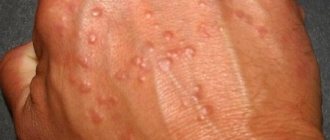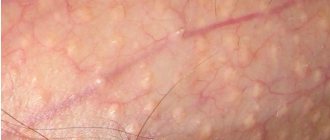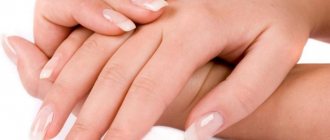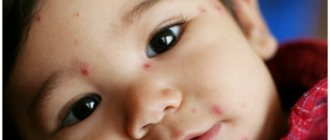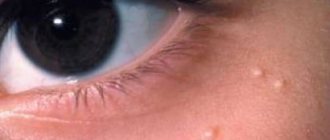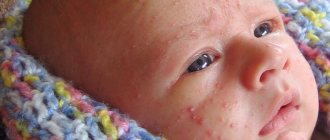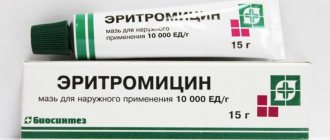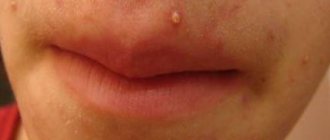Types of rash on the legs and its location
In some cases, the location of the rash may indicate the root cause of its appearance. For example, with allergies, irritation appears at the site of skin contact with the allergen. From poor-quality socks - on the feet and ankles, from diapers - on the butt and in the groin area.
A rash on a child’s feet indicates a fungus or neurodermatitis. Blood diseases affect the legs and feet. Miliaria manifests itself in places covered by clothing and folds (under the knees, in the armpits).
Infectious diseases in most cases lead to rashes throughout the body. With chickenpox, measles or rubella, blisters and pimples cover the child from the top of the head to the feet. However, at the very beginning of the disease, symptoms may appear only on the legs.
The term "rash" is general. It combines the names of various skin pathologies, which differ in appearance and nature of manifestation. In the photo below you can see different types of rashes.
Types of rash, as well as the reasons that can cause it:
- Small rash (red or pink). Allergic reaction, prickly heat, fungus, psoriasis, scabies, rubella. In each individual case, additional symptoms are present (fever, chills, itching, cracking or peeling).
- Large red. Large pimples in the form of “stars” all over the body indicate infection with meningococcus, which is extremely dangerous for infants and newborns. Large pimples only on the lower extremities indicate scabies (scabies mite).
- Transparent, colorless. Occurs with allergies, fungus, vitamin deficiency, hormonal imbalance and disorders of the gastrointestinal tract.
- Pimples (individual or in a large group). They appear in various pathologies and under the influence of the environment. Heat rash, allergic reaction, sunburn, chapping, streptococcus infection (streptoderma), dysbacteriosis, diabetes, poor hygiene, hormonal changes or disorders (for example, in a teenager), reaction to a vaccination or a new medicine.
- Rough dry. A characteristic symptom of scarlet fever. Accompanied by high fever, weakness, significant redness of the throat and tongue. Very contagious, transmitted by airborne droplets. Rough papules or nodules are present in atopic dermatitis.
As the disease progresses, spots and pimples can change into blisters and ulcers. Inflammation begins in the absence of timely medical care.
Treatment
Relief from itching. To relieve the severe itching that accompanies the disease, you need to use ointments, gels, and antihistamine creams.
A 1% menthol solution (alcohol) will not eliminate the cause of the disease, but will relieve itching.
A folk remedy will help get rid of the desire to scratch reddened areas: dilute 2 tbsp. l. lemon juice in 4 tbsp. l. water. Wipe the damaged areas of the skin of the legs with this solution.
Basic Rules
To get rid of hives quickly and without consequences, you need to follow the rules:
- identify the allergen to which the reaction occurred. Eliminate it from use;
- stop taking medications to which you are allergic;
- free the skin from contact with pressing parts of clothing, allow the feet to “breathe”, wear spacious shoes;
- put on your feet only things made from natural fabrics;
- wash your feet only with mild soap that does not contain fragrances or dyes;
- wrap the limbs with a rag soaked in cold water (cannot be used if you have a cold allergy);
- ventilate the room, do not overheat the room;
- follow a diet;
- calm down, watch a nice movie, listen to your favorite music.
Medication method
It is impossible to do without the use of medications in the treatment of urticaria on the legs. When taking medications, your legs will itch less, swelling and redness will subside.
Systemic treatment should be prescribed by a doctor who will select a specific drug and this will lead to rapid relief of the main symptoms of the disease. We will consider what means are available below.
Non-hormonal ointments
- Fenistil gel;
- Psilobalm;
- Nezulin cream;
- Skin-up ointment;
- Cream Gistan.
Hormonal
- Flucinar;
- Loriden;
- Cloveit;
- Celestoderm.
They begin to work in 5 minutes, the effect lasts up to 10 hours. Such ointments can be used no more than 2 times a day.
Pills
These antihistamines relieve the symptoms of hives for up to 8-10 hours.
Side effects include decreased attention, drowsiness, and apathy.
Diuretics
- Furasemide.
- Indapamide.
- Lingonberry leaf.
When using diuretics, allergens are removed from the body faster.
Vitamins and minerals
To normalize the gastrointestinal tract and heal the disease faster, you need to take vitamin preparations (if you are not allergic to medications or vitamins):
- ascorbic, nicotinic acids;
- calcium gluconate;
- iron supplements;
- vitamin B2.
Diagnostic methods
If suspicious rashes appear, you should immediately go to the doctor. First, go to the pediatrician for an initial examination, then to specialists (allergist, immunologist, dermatologist, infectious disease specialist, gastroenterologist, etc.).
General blood and urine tests are required. An additional blood test may be needed to detect infection (viruses, bacteria, fungus), special immunoglobulins (indicate an allergic reaction). In case of advanced pathology, the doctor will take scrapings from the affected areas of the epidermis.
Folk remedies
Alternative medicine can help treat hives on the legs.
- Nettle lotions.
Take 100 grams of nettle, boil it in 1 liter of water for 3-4 minutes. Let it brew for 1 hour, squeeze out. Apply this solution to areas of redness on the legs. Raspberry roots.
Boil 100 grams of raspberry roots in 1 liter of water, leave for an hour, then filter and drink 100 ml. decoction during the day. Swamp calamus.
Grind the root of the marsh calamus grass, use the powder before breakfast and dinner, 0.5 tsp. Hydrogen peroxide.
Treat the affected areas of the skin of the legs with a 3 percent solution of hydrogen peroxide until the symptoms of the disease disappear.
Treatment tactics depending on the causes of the symptom
A rash on a child’s legs requires qualified medical care. Treatment depends on the nature of the pathology. Often, adjusting your lifestyle and quality of life leads to improvements almost immediately. Complex treatment includes eliminating the underlying cause, external manifestations on the skin (local treatment), maintaining good hygiene, and proper nutrition.
Special therapy is prescribed by a specialist. It involves taking antiviral, antibacterial or antifungal drugs. However, most diseases require full child care, diet, and local treatment to relieve inflammation and itching.
Medications:
- age-appropriate antiallergic drugs - they relieve tissue swelling well and reduce discomfort (Fenistil, Erius, Zyrtec, Suprastin, Diazolin, etc.);
- corticosteroid ointments or creams;
- hormonal drugs for external use (Prednisolone, Kenalog, etc.);
- immunomodulators or immunostimulants (used in extreme cases in children after 3 years of age);
- ointments or gels to reduce inflammation and itching, as well as for rapid healing (Fenistil gel, Bepanten, Weleda, etc.);
- antiseptics - if necessary (Betadine, Chlorhexidine, Miramistin).
In addition to drug therapy, it is important to take care of personal hygiene, nutrition, and the environment. You should bathe your baby daily using soft baby products or just warm water (for babies). You need to give up low-quality cosmetics.
It is important to review your household chemicals, especially laundry detergents. It is better to switch to environmentally friendly hypoallergenic brands. The room must be clean. Bed linen, underwear and clothing should be made from natural fabrics.
If the cause of the problem is an allergy, you need to isolate the baby from the allergen, incl. provide a hypoallergenic diet. In other cases, especially with vitamin deficiency, it is important to review the baby’s diet. Good nutrition is important, which includes eating lean meat, fish, dairy products, vegetables, fruits, and cereals.
How to treat allergies
When experiencing skin rashes, many people look at their hands with horror, begin to panic and wonder what to do. There is no need to panic. First of all, to avoid complications, you need to start washing your hands with bactericidal, preferably liquid soap.
Household chemicals often lead to similar phenomena. The skin of the hands is sensitive and cannot withstand the onslaught of chemicals, as well as frequent contact with water. It is better to wear gloves when washing and using powders.
For itching and burning, you can use skin-soothing mash, baths with the addition of chamomile, or string. Baths with peat oxidate and a water temperature of 37°C help well. You need to repeat the procedure for several days. If a scabies mite has penetrated the skin, you cannot avoid treating the skin with Spregal, Benzyl benzoate. In this case, it is necessary to disinfect all things, treat them thermally or even chemically.
READ ALSO: Caring for problem skin after 30 at home
Allergies should not be confused with scabies. These are completely different diseases that differ in symptoms and treatment. It is best to seek help from a doctor immediately.
Preventive actions
Preventing rashes in children:
- strengthening the immune system;
- maintaining personal hygiene;
- use of quality care products;
- hypoallergenic household chemicals;
- high-quality shoes and clothing made from natural materials;
- proper nutrition (if necessary, exclusion of allergenic foods);
- wearing clothes appropriate for the weather by the child;
- timely and correct treatment of diseases;
- regular pediatrician visits and tests;
- careful attention to the health and well-being of the baby.
Pediatrician, allergist-immunologist, graduated from Samara State Medical University with a degree in Pediatrics. Read more »
Why do acne appear on thighs and how to get rid of them
Pimples on the thighs affect many people, regardless of age and gender.
Girls are especially concerned about this issue, since the beauty of their legs is the main part of their body.
Before you start the fight, it is important to figure out what caused such unpleasant pimples and only then act.
- All information on the site is for informational purposes only and is NOT a guide to action!
- can give you an ACCURATE DIAGNOSIS !
- We kindly ask you NOT to self-medicate, but to make an appointment with a specialist !
- Health to you and your loved ones!
What kind of rash starts on the feet in children
The child's body is most often exposed to infectious diseases, since the baby's immunity is still very weak. Also, a prerequisite for the occurrence of various infections is the state of the intestinal microbiocenosis.
Types of rashes in children
Infectious damage to the baby’s body often leads to a rash. To avoid possible complications if any type of rash occurs, you should contact a specialist (pediatrician). The location of the rash is extremely variable. It doesn't matter which part of the body may be affected by the active rash.
Rash in the form of burgundy dots
This rash, like small reddish dots, most often occurs due to allergic reactions.
Perhaps this is connected with the diet, with the foods consumed, with the tissues adjacent to the body.
Properties, traits, reasons:
- On the body, such a rash looks like reddish dotted spots that have an oval, round shape.
- Has no elevation above other parts of the body. The rash is distinguished only by color.
- The appearance of burgundy dots occurs due to powerful blood supply.
Hyperemia or arterial congestion increases blood flow, which leads to the appearance of such spots. - Red dots may have edges or edges. Or they can be solid.
This rash is divided into two main types:
- Roseola. The corresponding personality of this type of rash is its small size. It ranges from 3 to 30 millimeters.
- Erythema .
This rash is distinguished by the large size of its parts. From 3 cm. Most often located in the chest area. The corresponding color is bright scarlet.
Important! If the treatment is not performed correctly, depigmentation may form at the site of redness and dots. And healing will no longer lead to the original result (clean and healthy skin).
In this case, you need to resort to surgery.
Pimple-like rash
Acne is a reaction of the body to various external or internal environmental causes. Pimples also occur due to allergic reactions and infectious diseases.
Basic properties, description, prerequisites for the occurrence of acne:
- This rash has various forms and types.
It may appear as an abscess. It rises above the skin level and forms an oval pustule. - The size of such a rash is not extremely significant. About .5 mm in height.
- Shaped image: round pimple, cone-shaped pimple, internal (flat) pimple.
- The main cause of acne in young children is allergic reactions. This rash may be accompanied by itching and redness.
- The appearance of acne can also be caused by hereditary factors.
This disease can be transmitted from mother to child. - Stress often leads to this type of rash.
Pimple rashes are divided into 4 groups (according to the appearance and nature of the inflammation):
- Dry acne . The formation of such acne occurs in the winter season in both children and adults. They arise due to thickening of the stratum corneum of the epidermis. Healing is provided by cosmetic products that exfoliate dead skin particles and moisturize the skin.
- Watery pimples. They occur for almost all reasons (diathesis, consumption of low-quality food products, use of low-quality cosmetics - shampoos, creams, foams, soaps), but the most common is an allergic reaction to the product.
Liquid pimples are accompanied by itching. May be a symptom of scabies, measles, chickenpox, rubella, dyshidrosis. - Purulent acne. At first, this rash may look like small reddish dots, but after three to four days changes occur. Reddish spots turn into purulent pimples. This rash can be caused by a staphylococcal or streptococcal infection. You need to do a complete (clinical) blood test, a general urine test, and then contact a specialist. During the test period, you should avoid sweet foods to prevent bacteria from multiplying.
- Subcutaneous pimple. The appearance of such acne occurs due to clogging of the ducts with plugs of the sebaceous glands.
Traditionally, this phenomenon goes away without the help of others, but if no changes occur, you should contact a specialist for advice.
Blistering rash
The appearance of a blistering rash can lead to a number of extremely unsafe diseases:
- Pemphigus. This disease can lead a child to a fatal outcome. The immune system is damaged when the body begins to fight the waking cells.
- Dermatitis herpetiformis, which is an autoimmune disease.
The uniqueness of this disease is the appearance of bubbles and blisters.
The rash in the form of blisters can be of two forms:
- It may make up about 50% of the human body. Occurs in various parts of the body.
- Appears in a separate part of the body, forming only small round itchy redness.
This rash can appear due to:
- Allergic reactions of the body, skin.
- Systemic diseases.
- Skin diseases.
- Infectious diseases.
After healing, the bubble disappears, leaving no marks on the body.
To begin a course of healing, you need to identify the cause and stage of the disease, for which you need to contact a specialist.
Rash in the form of spots
This rash looks like spots with different colors (red, pink, yellowish, brown).
The color of the spot depends on melanin (skin pigment). If melanin is present, then the color of the skin with areas of spots will be darker. If melanin is absent, the color shade of the spots becomes the most striking and light.
A rash in the form of spots is appropriate for diseases such as:
- Measles
- Rubella
- Scarlet fever
- Skin tumors
- Various skin diseases.
Features of the rash in the form of spots:
- The rash is caused by hundreds of viral agents.
- This rash has a tendency for small round spots to form larger spots.
- Skin lesions most often occur in the chest (torso) area of the child.
- The rash may appear due to food, contact, or pharmaceutical allergies.
To accurately determine the level of this disease, identify the cause, and correctly prescribe treatment, you need to contact a specialist.
List of doctors who should be contacted for a rash in the form of spots:
- Dermatologist
- Neuropathologist
- Oncologist
- Allergist
- Surgeon
Here you can read more about reddish spots on the face.
Description of the main parts of the rash
The main elements of the rash:
- Tubercles protruding above the general level of the skin are cavityless formations measuring 1-5 mm (sometimes reaching up to 10 millimeters).
The tubercles can form ulcers or heal by replacing the infiltrate with the formation of an element of cicatricial atrophy of the skin in place. - Blisters are formations with a powerful inflammatory effect. The size of the blister reaches up to 10 cm. The skin inflammation is pale pink at the base and bright red in the middle of the element.
- Bubbles are small, liquid-filled cavity elements.
Their diameter is about 10 mm. They can occur due to burns, bites, various skin diseases, and allergic reactions. Vesicles (bubbles) appear as a result of the manifestation of diseases such as herpes infection, allergic dermatitis, autoimmune bullous diseases. - Spots are flat rashes on the human body.
Their diameter in the standard is about 10 mm. The spots come in various sizes, forming over a certain period of time the largest inflamed areas of the skin in diameter. - Papules (also called a node) are formations of a different mixture that protrude above the main level of the skin. They are divided into two types: inflammatory and non-inflammatory. Dimensions reach 5 mm. The shape is different.
- Vesicles are small cavity formations of hemispherical shape. Internally it contains a transparent or translucent liquid. It differs from the bubble in its smallest size.
- Pustules are pustules.
Inside the pustule there is grayish or snow-white pus. When infected, the pus turns green. - Roseola are small spots that do not rise above the skin level. Traditionally, groups of spots form.
- Hemorrhage is bleeding into the skin due to the destruction of blood vessels. It appears on the skin as small spots or dots of different shapes. It has a reddish and then yellowish color (during healing).
Characteristic location of the rash in children
Baby rash has different locations. The main location of one or another rash leads to the initial detection of the disease.
A baby's rash can be located in various places on the body, causing irritation, itching, acute pain, and unpleasant sensations.
So, the main location of the rash in children:
- The rash is located on the arms, elbows, wrists, and forearms.
- Sometimes the rash occurs on the legs (inside the leg). A more common cause is allergic reactions of children to food, but the most complex cases also occur.
- Most often, rashes appear on the face.
The focal point is the cheeks. - The torso is also subject to inflammatory effects. More often, rashes occur in the chest area, as well as in the scapular region.
Diseases accompanied by rash
Diseases that are accompanied by a rash:
- Allergic reactions often cause an active rash on the body . Each baby has its own allergen agent, which is very difficult to find. An allergic rash is simply visible - small dots, pimples, and blisters form all over the body, which rise above the skin level. Traditionally, the diameter of such parts is approximately 5 millimeters.
- Infection .
Occurs after contact with an unhealthy person. A striking example of this group of diseases is chickenpox. At first, a high temperature appears, after 3–4 days of illness, corresponding rashes appear on the child’s body.
What is the difference between an infectious rash?
Infection (measles, rubella, chickenpox) is a contagious disease.
It has the main distinctive properties from allergic and other diseases:
- Lymph nodes enlarge.
- Peeling of the skin. This quality is characteristic of almost all infectious diseases.
- Bubbles containing liquid form.
- Subcutaneous hemorrhages are more characteristic of measles.
If you have similar symptoms, you need to get qualified help from a specialist.
How to deal with a watery blister?
If children have pimples on their skin that contain liquid inside, then you need to visit a pediatric dermatologist as soon as possible. A specialist will help determine the source of the problem and assess its severity. Various diagnostic procedures may be required to confirm the diagnosis. To eliminate watery pimples above the head and in other areas of the child’s body, the drugs presented in the table are used.
| Group | Medicines |
| Antiviral agents | "Acyclovir" |
| "Panavir" | |
| "Virolex" | |
| "Penciclovir" | |
| Antihistamines | "Suprastin" |
| "Tavegil" | |
| "Desal" | |
| "Claritin" | |
| "Zyrtec" | |
| "Zodak" | |
| Medicines that eliminate itching and burning sensations in a child with a herpetic virus | "Bonafton" |
| "Zovirax" | |
| Preparations for healing acne with chickenpox | "Kalamine" |
| "Tsindol" | |
| "Fukortsin" | |
| Zinc ointment |
If a child has watery acne, you need to be especially careful about hygiene. During therapy, you should not use various cosmetics that can further irritate the baby’s epidermis. If the rash is associated with diaper dermatitis, it is recommended to carry out air baths more often. If the violation is caused by an allergic reaction to diapers, then you need to change the hygiene product. You can also use folk remedies, which are agreed with your doctor. Auxiliary medications for watery acne in children are chamomile decoction, calendula tincture, aloe juice and kalanchoe. It is possible to cope with the inflammatory reaction and itching sensations that are characteristic of pathological rashes on the skin with the help of healing baths with the addition of string, thyme or mint.
Signs and symptoms
Poll: When did your acne appear? (Number of votes: 4295)
I've been suffering all my life
It's been a couple of years now
About a few months
Recently
To vote, click on the desired answer. results
Viruses, which are accompanied by the appearance of pimples on the palms of the hands and feet, begin their action with an increase in temperature from 37 to 39, sore throat, sore throat, cough, headache, fatigue, loss of appetite and sometimes joint pain. After 1 - 2 days appears acne rash on the areas listed above.
Lesions on the hands and feet (limbs) begin as flat red spots that produce oval or cone-shaped blisters surrounded by red coloring. Lesions on the hands and feet are common on the sides and backs of the fingers and toes. The palms and soles of the hands may also be particularly affected.
- Skin lesions may be accompanied by pain.
- After about a week, the rash will disappear and your child will feel better.
Video: “How to get rid of acne - simple and clear”
Treatment for acne depends entirely on the cause of its appearance.
In any case, you can initially try to get rid of the unpleasant disease yourself. If within a week the disease progresses, then you should consult a doctor.
What to do if a pimple appears on your lip? Find out here.
When pimples appear, you want to get rid of them as quickly as possible and there is a temptation to squeeze them out. However, this is strictly not recommended. Why?
After such actions, an infection can be introduced into the skin, and after healing, unsightly scars will remain on it.
If the skin of your legs is strewn with rashes, then you should try the following effective treatment methods:
- replace trousers and tights with clothes made from natural fabrics;
- try to wear ankle boots with low tops;
- change cosmetic products, as you may be allergic to them;
Photo: drugs for acne treatment
- If the pimples are inflamed, then it is worth using medications. You can try to start using salicylic ointment, as well as the drugs “Dalacin”, “Zinerit” and “Skinoren”. If after a week of treatment, acne does not begin to go away, you should consult a doctor;
- It is important to take vitamin A regularly;
- minor rashes can be wiped with alcohol tinctures of chamomile or calendula;
- it is necessary to control the temperature in the room, this will reduce sweating, which causes clogging of pores;
- You can wipe pimples with saline solution.
- the skin must be given the opportunity to “breathe”; provide it with air treatments;
- single pimples should be cauterized with iodine.
Causes of pimples
Various rashes on the legs are caused by:
- diseases of an infectious or parasitic nature: measles, chickenpox, rubella, scarlet fever (characterized by fever, chills, cough, abdominal pain, attacks of nausea may appear, the rash is located on the limbs and throughout the body);
- allergies (provoked by the use of medications, contact with allergenic plants, animal hair, etc.);
- vascular diseases and pathologies of the circulatory system, blood poisoning (the affected area is extensive; accompanied by acute fever, can be fatal, requires immediate medical attention);
- unhealthy diet (frequent consumption of chocolate, citrus fruits, milk);
- failure to comply with personal hygiene rules (contributes to the development of diaper rash, prickly heat, diaper dermatitis).
